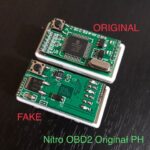Navigating the complexities of your vehicle’s onboard diagnostics system can be challenging, especially when you encounter terms like “Permanent Diagnostic Trouble Codes” (DTCs). For GM vehicle owners using OBD2 systems, understanding permanent DTCs is crucial for effective car maintenance and ensuring your vehicle is ready for emissions testing. Let’s delve into what Gm Obd2 Permanent DTCs are, how they function, and how you can address them.
What are Permanent DTCs in GM OBD2 Systems?
Permanent DTCs are a specific type of diagnostic code set in your vehicle’s computer when a malfunction is confirmed and the Malfunction Indicator Lamp (MIL), commonly known as the check engine light, is illuminated. Unlike regular DTCs that can be cleared using a scan tool or by disconnecting the battery, permanent DTCs are designed to remain until the vehicle itself verifies the issue is resolved.
The primary purpose of permanent DTCs is to prevent vehicles from deceptively passing emissions inspections. In the past, some vehicle owners would simply clear DTCs just before an inspection, masking underlying problems. Permanent DTCs prevent this by ensuring that even if codes are cleared with a scan tool, the permanent DTC remains, indicating a recent emission-related fault.
How to Clear GM OBD2 Permanent DTCs
It’s important to understand that you cannot manually clear permanent DTCs with a scan tool in the same way you clear regular codes. Instead, permanent DTCs are cleared automatically by the vehicle’s diagnostic system once certain conditions are met. There are two main ways a permanent DTC will be erased:
- Through Fault-Free Monitoring Cycles: The most common method is through consecutive fault-free monitoring cycles. Specifically, after three consecutive confirmed fault-free monitoring cycles, the MIL will turn off, and the permanent DTC will be automatically cleared at the beginning of the fourth fault-free monitoring cycle.
- After a “Clear DTC” Request and Fault-Free Cycle: If you use a scan tool to request a “clear DTC,” a permanent DTC will be erased after one confirmed fault-free monitoring cycle is completed.
To achieve a fault-free monitoring cycle, a specific driving cycle must be completed. This cycle ensures that the OBD monitor runs and verifies that the fault is no longer present. A typical driving cycle includes these conditions:
- The OBD monitor for the specific system must run and confirm the fault is resolved.
- The engine must have been running for more than 10 minutes cumulatively (or propulsion system active for hybrids).
- The vehicle must be operated above 25 MPH (40 km/h) for more than 5 minutes cumulatively.
- The vehicle must idle (accelerator pedal released, speed less than 1 MPH or 1 km/h) for more than 30 seconds continuously.
Addressing Potential Issues with Clearing Permanent DTCs
Sometimes, even after driving and attempting to complete the necessary cycles, a permanent DTC may persist. In such cases, it’s important to consider a few factors:
- Underlying Issues Not Fully Resolved: While you might have addressed the initial problem, there could be related or intermittent issues preventing the system from registering a fault-free cycle.
- Tuning or Modifications: As highlighted in the original post, aftermarket tunes or modifications to your vehicle’s engine control system could potentially interfere with the OBD monitoring system’s ability to properly run and clear permanent DTCs. If you have a tune, it might be worth investigating if it’s impacting the DTC clearing process.
- Incomplete Driving Cycle: Ensure you are accurately completing the full driving cycle, including the idle period, as this is often a step that can be missed.
Conclusion
Understanding GM OBD2 permanent DTCs is vital for maintaining your vehicle and ensuring it meets emission standards. Remember, these codes are designed to ensure issues are genuinely resolved, not just temporarily masked. By understanding how permanent DTCs work and the conditions required to clear them, you can effectively address any underlying problems and keep your GM vehicle running smoothly and legally. If you are struggling to clear a permanent DTC, consult a qualified mechanic to diagnose any persistent issues and ensure your vehicle completes the necessary monitoring cycles.
